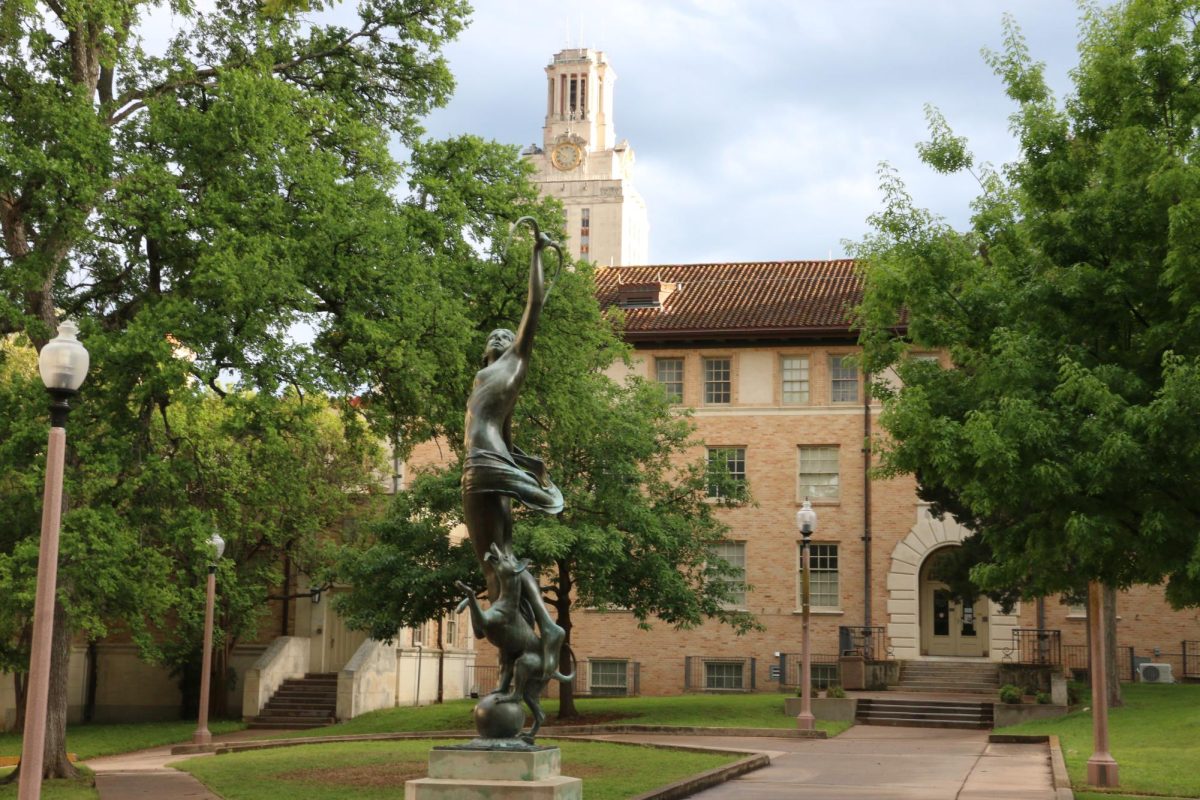The University allowed female students to attend its schools from its inception in 1883, joining few universities that admitted both female and male students at the time, almost four decades prior to the 19th Amendment.
Despite this, out of all of the buildings located on UT Austin’s main campus, only seven are named after women: five residence halls and two academic buildings.
Andrews Hall
According to the University, 26% of UT’s first enrolled class was female. All of the University’s instructors were male.
Jessie Andrews was the first woman to change that.
Portraits of Andrews show a stylish woman wearing the staples of Victorian-era fashion. Fabric and pearl necklaces brushed against a ruffled and flowery collar with matching pearl earrings. There’s a sharpness in her eyes.
Andrews was the University’s first female instructor and, before that, the University’s first female graduate.
“UT was always ahead to have a woman (as) a college instructor in the 1890s and late 1880s,” Jim Nicar, owner of the UT History Corner blog, said. “Consider that Princeton University was not co-ed until (1969) … (UT) was ahead of its time.”
Edmund Gordon, professor of African and African Diaspora studies, said the University’s decision to name Andrews Hall after the poet and instructor invokes a particular history and set of values — in this case, equal opportunities for women in higher education.
“When they are trying to honor somebody, they’re honorific but they’re also trying to (inspire) you to have social memory,” said Gordon, executive director of Contextualization & Commemorative Initiative. “They’re also trying to (inspire) you with a certain set of values, aspirations and possibilities. That’s pretty powerful.”
Andrews also wrote poetry. Her rhymes and stanzas were published in magazines and her book was published in 1910.
Andrews graduated with a German degree and taught the language at the University until 1918. She passed away in 1919, 16 years before the Andrews residence hall was constructed.
Teresa Lozano Long Institute of Latin American Studies
A replica of an Olmec colossal head marks the entrance into the Nettie Lee Benson Library and the Teresa Lozano Long Institute of Latin American Studies. Director of the institute, Adela Pineda, said the Olmec head was a gift to the University from the Mexican government and symbolizes a close relationship between the Institute and Latin American institutions.
As a Mexican international student, Pineda, a graduate of the Institute, said she always felt comfortable in the Institute.
“The Institute became my first home in the United States,” said Pineda, who graduated when the Institute was still only known as the Institute of Latin American Studies. “When I read about Teresa Lozano, I identified myself with her (and) with her mission.”
Lozano, the namesake of the Institute, grew up in a small South Texas town, where she recalled her family driving hours to San Antonio for doctor’s visits.
Lozano obtained three degrees from the University, becoming the first Mexican-American woman to earn a doctorate degree from UT in health and physical education.
“Teresa was a force of nature,” Pineda, who is still in contact with Lozano’s widow, former attorney and business-man Joe Long, said. “(Against) all odds, she became this prominent figure … and wanted to make a difference for Latin Americans.”
In 2000, the Longs made a $10 million endowment to the University in support of the Institute. The University renamed the school to honor Lozano, including her maiden name as a tribute to her Mexican heritage, Pineda said.
“I think the Longs understood why the Institute was so important for UT Austin, why it needed a permanent source of funding,” Pineda said.
The Institute was not the pair’s only contribution to Texas arts and schools. The Joe R. & Teresa Lozano Long School of Medicine was renamed after the couple for their donation of over $61 million to UT Health San Antonio. The Long Foundation in Austin was named for the pair, cementing their commitment to the cultivation of arts.
Lozano received the National Humanities Medal in 2019, adding to her long list of campus and state-wide recognitions. She died in 2021, leaving behind her husband and hundreds of students she helped educate.
Almetris Duren Hall
Duren Hall stands tall on the edge of campus, tucked on the corner of 27th Street and Whitis Avenue. The outside is basic tan stone adorned with an array of brick red roofs.
Almost immediately to the left of the building’s entrance is a black and white portrait of Almetris Marsh Duren. She oversees the front desk, with her dark, wide curls styled in a bob away from her face.
Duren would spend most of her life as a guiding light for Black students at the beginning of the University integration.
In 1956, UT finally opened undergraduate admissions to Black applicants, 104 total, according to Duren’s recollection in her book “Overcoming: A History of Black Integration at the University of Texas at Austin.” However, admission to the University did not mean fair opportunities for Black students.
She said there was an “unwritten policy” barring Black students from participating in sports, the marching band and other public performances as well as housing disparities.
“Both problems were to be discussed and fought over, to cause pain and anger, and to be tackled on a piecemeal basis for a number of years before they were finally resolved,” Duren said in her book.
Originally, the only housing available to Black female students was an East Austin dorm called Eliza Dee Hall owned by Huston-Tillotson University. The University hired Duren as house matron to guide the first Black female students, who were navigating a newly integrated university.
When the hall was set for demolition in 1958, Duren and her residents moved to a new building on Whitis Avenue, quickly named Almetris Co-op.
“The move for better housing was but one aspect of changing precedents and changing moods, not just on campus but throughout the South,” Duren wrote.
While closer to classes and other aspects of student life, the facilities, with poor air ventilation and faulty wiring, were simply not equal to the all-white dormitories.
Throughout the 1960s, Duren saw various student-led protests advocating for integration of not just housing but all aspects of UT student life. Later on in her career at the University, she witnessed the implementation of UT’s first ethnic studies course, which began as a single class offered in 1968.
After her influential co-op was demolished for a new communications building, Duren became a resident of Jester until her retirement in 1980. She is credited with starting the University’s first minority recruitment program and won several distinctions, such as the Presidential Citation for Outstanding Service, in her later years at UT.
Duren Hall was officially opened in 2007, creating a new symbol for Duren’s lasting legacy on campus. A dedication ceremony was held in October of that year.
Gordon, founder of the Racial Geography Tour, a walking and digitized tour of University landmarks, said the University’s commemoration of Duren impacts current commemoration efforts of Black achievement at the University.
“It really meant a lot, particularly to the older Black students, that the University was prepared to celebrate that aspect of its history,” Gordon said.
In a letter to nephew Vidal Duren, Peggy Drake Holland, the first Black woman to graduate from UT with a business degree and namesake of a student lounge and exhibit in the McCombs School of Business, commemorated Duren’s influence in a letter to nephew Vidal Duren.
Holland, a former Almetris co-op resident, said not just one or two words could describe Duren.
“She will never be forgotten for we (all Black students who knew her) were grateful to her for something,” Holland wrote. “She was an exceptional human being. Everyone you could talk to has a good story to tell.”
Editor’s Note: This story has been updated to reflect that the statue in the Nettie Lee Benson Library was a gift from the Mexican government. The Texan regrets this error.





















